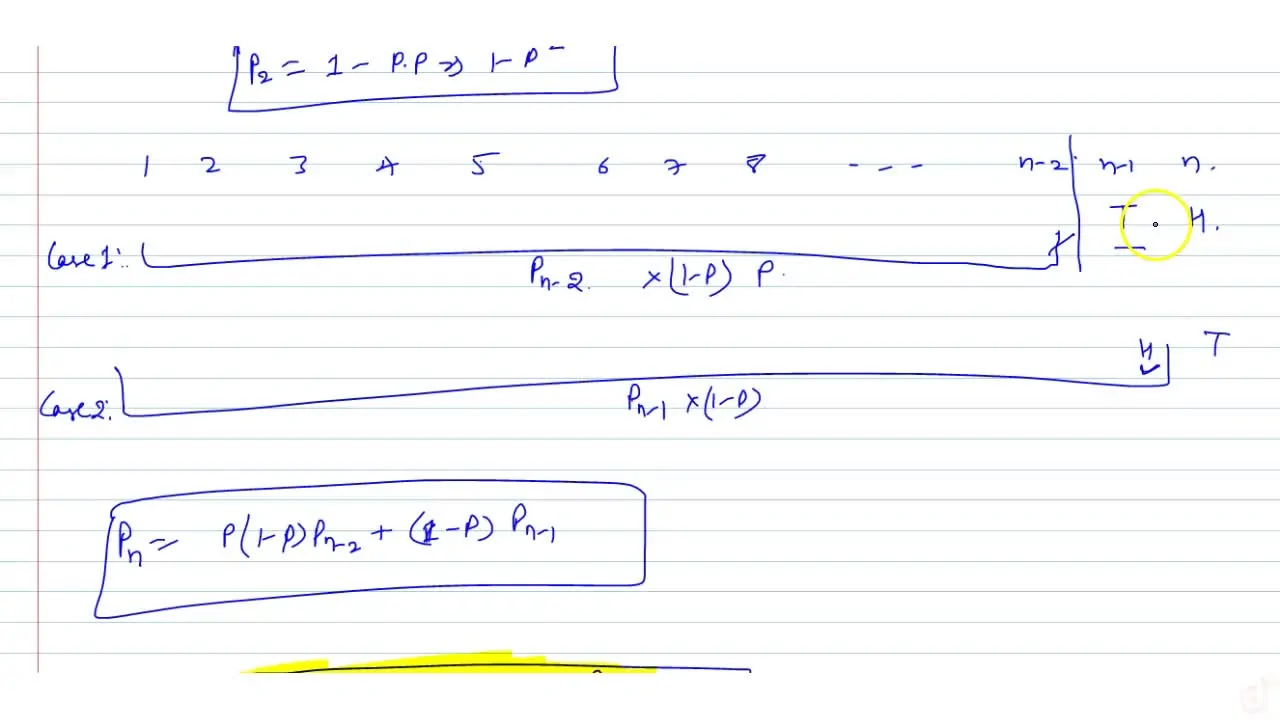It is tossed n times. Let Pn denote the probability that no two (or more) consecutive heads occur. Prove that P1=1,P2=1−p2andPn=(1−P)Pn−1+p(1−P)Pn−2 for all n≤3.
Given that the probability of showing head by a coin when tossed is p.
So, the probability of coin not showing head is (1-p). Now, pn denotes probability that no two or more consecutive heads occur in n throws.
Clearly, p1=1 as when coin is tossed once there will be no two consectiven heads.
Also, p2=P(HT)+P(TH)+P(TT)
=p(1−p)+p(1−p)+(1−p)2=1−p2
Let event A is "last toss is tail" and evetn B is "last toss is head and second last toss is tail."
∴ Using total probability theorem,
pn=pn−1×P(A)+pn−2×P(B)
∴pn=(1−p)pn−1+p(1−p)pn−2for all n≥3.
Related Playlists
- BOOK - CENGAGECHAPTER - PROBABILITY IIEXERCISE - Exercise 14.19videos
PROBABILITY II
- BOOK - CENGAGECHAPTER - PROBABILITY IIEXERCISE - Exercise 14.23videos
PROBABILITY II
- BOOK - CENGAGECHAPTER - PROBABILITY I EXERCISE - JEE Advanced Previous Year7videos
PROBABILITY I
- BOOK - CENGAGECHAPTER - PROGRESSION AND SERIESEXERCISE - ARCHIVES (MATRIX MATCH TYPE )1videos
PROGRESSION AND SERIES
Similar Questions
It is tossed n times. Let Pn denote the probability that no two (or more) consecutive heads occur. Prove that P1=1,P2=1−p2andPn=(1−P)Pn−1+p(1−P)Pn−2 for all n≤3.
View SolutionIf (2n+1)Pn−1:2n−1Pn=3:5,find n.
View SolutionFind n if
2×nP3=n+1P3View SolutionLet P(n) denote the statement that n2+n is odd. It is seen that P(n)⇒P(n+1) then P(n) is true for all
View SolutionIf 2n+1Pn−1:2n−1Pn=3:5, then find the value of n.
View SolutionIf n+5Pn+1=11(n−1)2n+3Pn , find n.
View Solution2.nP3=n+1P3
View SolutionLet P(n) denote the statement that n2+n is odd . It is seen that P(n)⇒P(n+1),P(n) is true for all
View SolutionLet P(n) denote the statement that n2+n odd .it Is seen that P(n)=P(n+1) ,P(n) is true for all
View SolutionLet P(n) denote the statement that n2+n odd .it Is seen that P(n)=P(n+1) ,P(n) is true for all
View Solution


